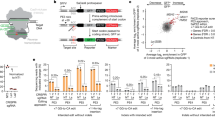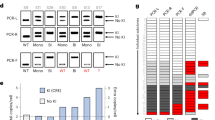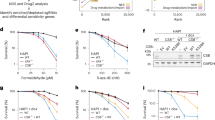Abstract
The targeting range of CRISPR–Cas9 base editors (BEs) is limited by their G/C-rich protospacer-adjacent motif (PAM) sequences. To overcome this limitation, we developed a CRISPR–Cpf1-based BE by fusing the rat cytosine deaminase APOBEC1 to a catalytically inactive version of Lachnospiraceae bacterium Cpf1. The base editor recognizes a T-rich PAM sequence and catalyzes C-to-T conversion in human cells, while inducing low levels of indels, non-C-to-T substitutions and off-target editing.
This is a preview of subscription content, access via your institution
Access options
Access Nature and 54 other Nature Portfolio journals
Get Nature+, our best-value online-access subscription
$29.99 / 30 days
cancel any time
Subscribe to this journal
Receive 12 print issues and online access
$209.00 per year
only $17.42 per issue
Buy this article
- Purchase on Springer Link
- Instant access to full article PDF
Prices may be subject to local taxes which are calculated during checkout


Similar content being viewed by others
Accession codes
References
Komor, A.C., Kim, Y.B., Packer, M.S., Zuris, J.A. & Liu, D.R. Nature 533, 420–424 (2016).
Nishida, K. et al. Science 353, aaf8729 (2016).
Kim, K. et al. Nat. Biotechnol. 35, 435–437 (2017).
Zong, Y. et al. Nat. Biotechnol. 35, 438–440 (2017).
Li, G. et al. Protein Cell 8, 776–779 (2017).
Kim, Y.B. et al. Nat. Biotechnol. 35, 371–376 (2017).
Kleinstiver, B.P. et al. Nature 523, 481–485 (2015).
Zetsche, B. et al. Cell 163, 759–771 (2015).
Yamano, T. et al. Cell 165, 949–962 (2016).
Stella, S., Alcón, P. & Montoya, G. Nature 546, 559–563 (2017).
Swarts, D.C., van der Oost, J. & Jinek, M. Mol. Cell 66, 221–233.e224 (2017).
Kim, D. et al. Nat. Biotechnol. 34, 863–868 (2016).
Kleinstiver, B.P. et al. Nat. Biotechnol. 34, 869–874 (2016).
Yan, W.X. et al. Nat. Commun. 8, 15058 (2017).
Chen, J., Miller, B.F. & Furano, A.V. eLife 3, e02001 (2014).
Staahl, B.T. et al. Nat. Biotechnol. 35, 431–434 (2017).
Komor, A.C. et al. Sci. Adv. 3, eaao4774 (2017).
Kim, H.K. et al. Nat. Methods 14, 153–159 (2017).
Bae, S., Park, J. & Kim, J.S. Bioinformatics 30, 1473–1475 (2014).
Rees, H.A. et al. Nat. Commun. 8, 15790 (2017).
Gao, L. et al. Nat. Biotechnol. 35, 789–792 (2017).
Wang, L. et al. Cell Res. 27, 1289–1292 (2017).
Li, B. et al. Nat. Biomed. Eng. 1, 0066 (2017).
Acknowledgements
This work was supported by grants 2014CB910600 (L.Y.) from MOST; grants 31600619 (B.Y.), 31600654 (J.C.), 31471241 (L.Y.), 31730111 (L.Y.) and 91540115 (L.Y.) from NSFC; and grants 16PJ1407000 (J.C.) and 16PJ1407500 (B.Y.) from the Shanghai Municipal Science and Technology Commission.
Author information
Authors and Affiliations
Contributions
J.C., X.H. and L.Y. conceived, designed and supervised the project. J.C. managed the project. X.L. and Y.L. performed most experiments on plasmid construction and cell culture with the help of X.W., Z.L., Y.Z. and J. Wu. J. Wei. prepared libraries for deep sequencing, and Y.W. performed bioinformatics analyses, supervised by L.Y. J.C., B.Y. and L.Y. wrote the paper with input from all authors.
Corresponding authors
Ethics declarations
Competing interests
The authors declare no competing financial interests.
Integrated supplementary information
Supplementary Figure 1 dLbCpf1-BE0 but not dAsCpf1-BE0 induced C-to-T base editing in the episomal shuttle vector system
(a) Schematic diagram illustrating the procedures to determine the base editing induced by dLbCpf1-BE0 or dAsCpf1-BE0 in episomal shuttle vectors. (b) Number of E. coli colonies containing mutated shuttle vectors that were induced by dAsCpf1-BE0 or dLbCpf1-BE0. (c) C-to-T editing frequencies were determined at the indicated cytosines. The cytosines were counted with the base proximal to the PAM setting as position 1. Frequencies were calculated from data in (b). Means ± s.d. were from three independent experiments.
Supplementary Figure 2 Effect of crRNA spacer length on editing efficiency
(a) Number of colonies containing mutated shuttle vectors that were induced by dCpf1-BE0 and crRNAs of different length. (b) C-to-T editing frequencies induced by dCpf1-BE0 and crRNAs of different length were determined at the indicated cytosines in episomal shuttle vectors. The crRNAs with the spacer length ranged from 19 to 27 nt showed similar base editing efficiencies at most of the editing positions. Frequencies were calculated from data in (a). Means ± s.d. were from three independent experiments.
Supplementary Figure 3 The internal NLS (iNLS) between dCpf1 and UGI is crucial for base editing induced by dCpf1-BE0
(a) Schematic diagram illustrating the design of expression vectors of dCpf1-BE0 and dCpf1-BE0ΔiNLS. (b) The C-to-T editing frequencies of the indicated cytosines were individually determined at different genomic target sites under the treatment of dCpf1-BE0 (blue) or dCpf1-BE0ΔiNLS (green). (c) The normalized C-to-T editing frequencies induced by dCpf1-BE0 and dCpf1-BE0ΔiNLS in genomic DNA, setting the ones induced by dCpf1-BE0 as 100%. (d) Statistical analysis of the normalized C-to-T editing frequencies. The dCpf1-BE0 induced significantly higher C-to-T editing frequencies than dCpf1-BE0ΔiNLS. P values, one-tailed Student’s T test. The median, interquartile range (IQR) and 1.5 × IQR are shown. n = 54 independent samples from 3 independent experiments. (e) The indel frequencies were determined at indicated loci in genomic DNA. 293FT cells were either treated with dCpf1-BE0 (blue), with dCpf1-BE0ΔiNLS (green) or non-transfected (gray) before deep sequencing. Asterisk denotes an unusually high basal indel frequency (or amplification, sequencing, alignment artifact) at the examined RUNX1 site in the non-transfected 293FT cells. Means ± s.d. were from three independent experiments.
Supplementary Figure 4 Additional N-terminal NLS enhanced the base-editing efficiency of dCpf1-BE in genomic DNA
(a) Schematic diagram illustrating the design of expression vectors of dCpf1-BE0 and dCpf1-BE. (b) The C-to-T editing frequencies of the indicated cytosines were individually determined at different genomic target sites. 293FT cells were either treated with dCpf1-BE0 (blue), dCpf1-BE (purple) or left non-transfected (gray) before deep sequencing. (c) The normalized C-to-T editing frequencies induced by dCpf1-BE0 and dCpf1-BE in genomic DNA, setting the ones induced by dCpf1-BE0 as 100%. (d) Statistical analysis of the normalized C-to-T editing frequencies. The dCpf1-BE induced significantly higher C-to-T editing frequencies than dCpf1-BE0. P values, one-tailed Student’s T test. The median, IQR and 1.5 × IQR are shown. n = 54 independent samples from 3 independent experiments. (e) The indel frequencies were determined at indicated loci in genomic DNA under different conditions. Asterisk denotes an unusually high basal indel frequency (or amplification, sequencing, alignment artifact) at the examined RUNX1 site in the non-transfected 293FT cells. Means ± s.d. were from three independent experiments.
Supplementary Figure 5 Features of dCpf1-BE-induced base editing
(a) Summary of the base editing frequency at each cytosine in the spacer region for the indicated 14 crRNAs. These data show that the major editing window ranges from the position 8 to 13 in spacer region. (b) The indel frequencies were determined at indicated loci in genomic DNA under different conditions. 293FT cells were either treated with dCpf1-BE (purple) or non-transfected (gray) before deep sequencing. Asterisk denotes an unusually high basal indel frequency (or amplification, sequencing, alignment artifact) at the examined RUNX1 site in the non-transfected 293FT cells. Means ± s.d. were from three independent experiments. (c) The fractions of cytosine substitutions induced by dCpf1-BE were individually determined at the indicated cytosines. (d) Statistical analysis showed that the C-to-T fraction of base editing outcome induced by dCpf1-BE was significantly higher than that induced by nCas9-BE3. The median and IQR are shown. P values, one-tailed Student’s T test. n = 42 independent samples from 3 independent experiments.
Supplementary Figure 6 Base editing was induced by dCpf1-BE in U2OS cells
(a) The C-to-T editing frequencies of the indicated cytosines were individually determined at the indicated genomic target sites. U2OS cells were either treated with dCpf1-BE (purple) or non-transfected (gray) before deep sequencing. (b) The indel frequencies were determined at indicated loci in genomic DNA under different conditions. Asterisk denotes an unusually high basal indel frequency (or amplification, sequencing, alignment artifact) at the examined RUNX1 site in the non-transfected U2OS cells. (c) The fractions of cytosine substitutions induced by dCpf1-BE were individually determined at the indicated cytosines. (a, b) Means ± s.d. were from three independent experiments.
Supplementary Figure 7 Determination of base editing induced by dCpf1-BE at predicted off-target sites
(a) The sequences of on- and off-target sites for the indicated crRNAs. The cytosines were counted with the base proximal to the PAM setting as position 1. (b) The C-to-T editing frequencies of the indicated cytosines were individually determined at the indicated on- and off-target sites. 293FT cells were either treated with dCpf1-BE (purple) or non-transfected (gray) before deep sequencing. Means ± s.d. were from three independent experiments.
Supplementary Figure 8 No substantial C-to-T editing was detected in the region outside of the spacer
(a) Schematic diagram illustrating the PAM region, the 20-nt region upstream of PAM and the 20-nt region downstream of spacer. (b) The C-to-T editing frequencies of the indicated cytosines outside of the spacer region were individually determined at the indicated sites. 293FT cells were either treated with dCpf1-BE (purple) or non-transfected (gray) before deep sequencing. Means ± s.d. were from three independent experiments.
Supplementary Figure 9 Multiple C-to-T editing was induced by dCpf1-BE when more than one cytosine was in the spacer region
The frequencies of single and multiple C-to-T editing induced by dCpf1-BE at the indicated cytosines were determined at different genomic target sites. The deep sequencing data are same as in Figure 1a. Means ± s.d. were from three independent experiments.
Supplementary Figure 10 W90Y and R126E mutations in rat APOBEC1 (rA1) narrowed the base-editing window to 3 nt
(a) Schematic diagram illustrating the design of expression vectors of dCpf1-BE, dCpf1-BE-YE and dCpf1-BE-YEE. (b) The normalized ratios of major editing to minor editing induced by dCpf1-BE (purple) and dCpf1-BE-YE (magenta), setting the ones induced by dCpf1-BE as 100%. (c) The fractions of single and multiple C-to-T conversions induced by dCpf1-BE and dCpf1-BE-YE. (d) Statistical analysis showed that the fraction of single C-to-T conversion induced by dCpf1-BE-YE was significantly higher than that induced by dCpf1-BE. P values, one-tailed Student’s T test. The median and IQR are shown. n = 15 independent samples from 3 independent experiments. (e) The indel frequencies were determined at the indicated genomic loci from the 293FT cells transfected with dCpf1-BE (purple), dCpf1-BE-YE (magenta), dCpf1-BE-YEE (yellow) or non-transfected (gray). Asterisk denotes an unusually high basal indel frequency (or amplification, sequencing, alignment artifact) at the examined RUNX1 site in the non-transfected 293FT cells. (b, e) Means ± s.d. were from three independent experiments.
Supplementary Figure 11 The fusion of three copies of 2A-UGI sequences did not substantially affect editing efficiency and induced no detectable indel formation
(a) Schematic diagram illustrating the design of expression vectors of dCpf1-BE and dCpf1-eBE. (b) The base editing frequencies induced by dCpf1-BE (purple) and dCpf1-eBE (green) were determined at indicated positions in genomic DNA. (c) The indel frequencies were determined at the indicated genomic loci. The 293FT cells were either treated with dCpf1-BE (purple), dCpf1-eBE (green) or left non-transfected (gray) before deep sequencing. (d) Schematic diagram illustrating the design of expression vectors of dCpf1-BE-YE and dCpf1-eBE-YE. (e) The base editing frequencies induced by dCpf1-BE-YE (magenta) and dCpf1-eBE-YE (brown) were determined at the indicated positions in genomic DNA. (f) The indel frequencies were determined at the indicated genomic. The 293FT cells were either treated with dCpf1-BE-YE (magenta), dCpf1-eBE-YE (brown) or non-transfected (gray) before deep sequencing. Asterisk denotes an unusually high basal indel frequency (or amplification, sequencing, alignment artifact) at the examined RUNX1 site in the non-transfected 293FT cells. Means ± s.d. were from three independent experiments.
Supplementary information
Supplementary Text and Figures
Supplementary Figures 1–11, Supplementary Tables 1 and 2, and Supplementary Notes 1 and 2 (PDF 5899 kb)
Supplementary Table 3
Calculation of indels (XLSX 53 kb)
Supplementary Table 4
Calculation of base substitutions (XLSX 2440 kb)
Rights and permissions
About this article
Cite this article
Li, X., Wang, Y., Liu, Y. et al. Base editing with a Cpf1–cytidine deaminase fusion. Nat Biotechnol 36, 324–327 (2018). https://doi.org/10.1038/nbt.4102
Received:
Accepted:
Published:
Issue Date:
DOI: https://doi.org/10.1038/nbt.4102
This article is cited by
-
Precise fine-turning of GhTFL1 by base editing tools defines ideal cotton plant architecture
Genome Biology (2024)
-
Precise genome-editing in human diseases: mechanisms, strategies and applications
Signal Transduction and Targeted Therapy (2024)
-
Base editing of organellar DNA with programmable deaminases
Nature Reviews Molecular Cell Biology (2024)
-
CRISPR/Cas-mediated germplasm improvement and new strategies for crop protection
Crop Health (2024)
-
Systematic optimization of Cas12a base editors in wheat and maize using the ITER platform
Genome Biology (2023)



